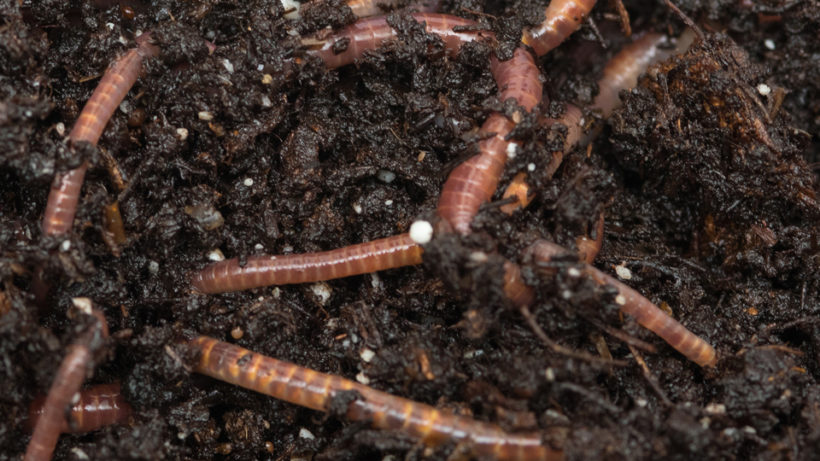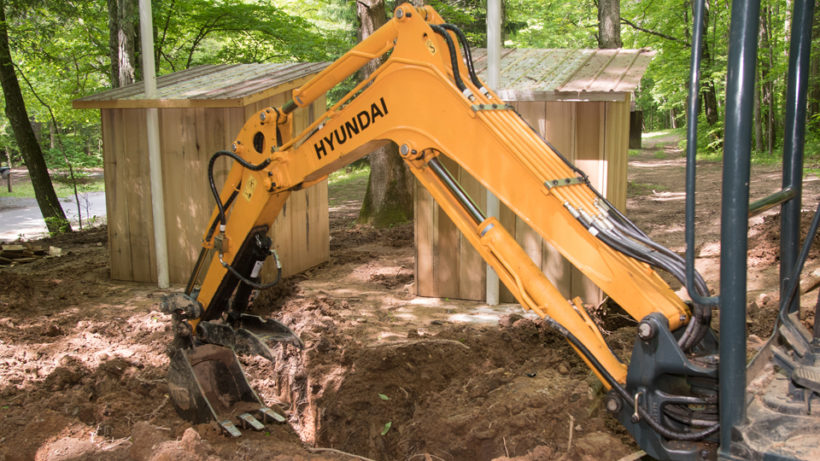Stinky, fly-infested pit toilets might someday disappear from America’s campgrounds, thanks to the dietary proclivities of a humble little worm.
Red wiggler worms have a unique talent. They gobble up organic material and turn it into rich topsoil. Some clever folks have harnessed this ability and are building privies as clean as they are green.
The technology, employed in developing countries for almost a decade, has proven a boon to public health. In Ghana, for example, wiggler-powered toilets helped eradicate dracunculiasis, a parasite-generated disease that once afflicted hundreds of thousands. At Camp Creek State Park and Forest in West Virginia, the toilets are giving campers and backpackers the unfamiliar experience of breathing fresh air while visiting a public privy.
“Guests who have used them have made many positive comments about them,” says Frank Ratcliffe, the superintendent at Camp Creek. “Think about that. We don’t usually get positive comments about any kind of restroom facility, let alone outhouses.”
Stephen Mecca, a Providence College physicist, pioneered the toilets’ design when he invented what he calls the “microflush valve.” Conventional toilets use gallons of water for each use; microflush toilets use just 8 ounces.

When flushed, liquid and solid waste products in the toilet bowl drop onto a rearward-slanting grate covered with straw, topsoil and oodles of ravenous red wigglers. Liquids filter through the soil and collect in a “soak hole,” a miniature leach field like those used in rural septic systems. Worms devour the solids and, within a week, transform them into fully composted topsoil. The slanted grate pitches the topsoil to the rear of the pit, where it’s readily harvested and used in gardens.
Mecca’s valve keeps offensive odors from rising up through the toilet itself. An exhaust stack at the rear of the loo allows the unpleasantness to dissipate well away from humans’ discerning noses.
At the heart of the system burrow the red wigglers (Eisenia fetida), also known as tiger worms, redworms, brandling worms, trout worms and panfish worms. Their species name, fetida (formerly foetida), comes from the pungent, foul-smelling liquid they excrete when handled roughly. Native to Europe, they’re now found on every continent except Antarctica. Organic gardeners might recognize them as “composting worms,” which can be purchased from worm farmers.
Red wigglers look a lot like standard-issue earthworms, but they’re not exactly dirt-dwellers. They prefer decaying organic material, and are most commonly found in rotting vegetation, compost heaps, and — you guessed it — manure piles.

The worms’ penchant for poo-gobbling helped work a minor miracle in Ghana, where poor sanitation contributed to a public health crisis that raged for decades. In 1989, an estimated 179,000 Ghanians suffered from dracunculiasis, a disease borne by parasitic Guinea worms.
Guinea worms’ larvae thrive inside water fleas that inhabit pools of contaminated water. People who drink the water ingest the larvae as they ingest the fleas. The larvae then grow into adult worms, 1 to 2 mm in diameter and up to 80 cm (31 inches!) long.
After a year of burrowing through their unfortunate hosts’ bodies, they slowly bore their way out. The best way to get rid of them is to wind them up on sticks as they crawl out, a process that take weeks. Pain from the wound can persist for months.

In 2009, workers for the Global Sustainable Aid Project (GSAP) began teaching Ghanians how to build microflush toilets. The privies, each built to process the wastes from two to three families, prevented sewage from contaminating water supplies. In 2015, officials from the World Health Organization certified that dracunculiasis had been eradicated within the country.

Red-wiggler technology made the jump from Africa to West Virginia in 2016, when a park visitor complained about a particularly foul-smelling Port-a-John. The man was a local member of Rotary International, which had worked with GSAP to bring microflush privies to Ghana.
“He said what we really needed was one of the toilets they helped build there,” says superintendent Ratcliffe.
Two local Rotary Clubs teamed up with GSAP and the park’s foundation to build that first outhouse. Ratcliffe says it was the first use of microflush technology for public use in the United States.
Completed in 2017, with a translucent roof and a cistern to collect rainwater for hand-washing and flushing, the bright, airy outhouse cost just $700 to construct. Visitors loved it so much Ratcliffe decided to build two more. State officials now want to extend red-wiggler technology into other parks, particularly in rustic camping areas.
“They’ll eliminate old-fashioned earthen pit toilets, the flies and the smell,” Ratcliffe says. “They’re a very clean, very neat solution to a long-time problem.”




The article didn’t educate the reader as to what this outhouse is and how it works. Might take another run at it.
I have an outhouse that doesn’t smell and doesn’t attract flies. It may be because the water table in my part of the island of Hawaii is very low, so the outhouse is always dry, even during and after a very heavy rain. Saw dust is added after every use. I plan on introducing composting worms soon.
Please don’t do this – especially in a forest! Non-native earthworms are harming our forests. You can see pictures of forests with and without earthworm invasions at http://greatlakeswormwatch.org.
After reading the concerns of many of those who commented here, I contacted Dr. Mecca to see if he could address the invasive-species issue. Unfortunately, Dr. Mecca passed away in late August. This reply, slightly abridged to focus on the crux of the questions, came from Dr. Mecca’s son, Steve Mecca:
“There are, in every continent on earth except for Antarctica, one or more varieties of E. fetida that digest various organic matter, including human waste. So the reference to red wiggler worms that Frank Ratcliffe mentioned [in the article] is the local species. The Microflush Toilet is now in 22 countries.”
I interpreted this response to say that people who build microflush toilets should find and use indigenous species of E. fetida.
I would like to build a privy pot in which to deposit materials when I do poop patrol in my yard. Can I get the human level plans and I try to retro-construct one for myself use?
As a nature directed and science based organization I hope that someone at TNC has considered whether these worms have the potential to be destructive of the natural soil layers before promoting them as Cool Green Science. I see I’m not the first to comment on this. How about a response from the author / editor?
This seems to be a wonderful solution to the problem of stinky roadside pit toilets that are found along some Wisconsin secondary highways. It had seemed that due to a severe lack of funds, constructing proper all-season indoor flush toilets could not be achieved, save for only a few along the interstate highways. Also the toilets at state parks are often pit toilets, and thus smelly and objectionable. At only about $ 700 to build one, I would be willing to pay an extra $700 to the state to build one of these, and since I am sure that there are at least 1000 other Wisconsin residents that are keen on our state parks and for attracting tourists and campers, this sounds like it could be easily achieved. Let’s do it.
It would be nice to have these along the AT shelter sights.
This low tech solution is impressive! I’d like to install one in our community garden, to replace a porta-potty that costs us $150/month. We’d pay off the new unit in 5 months.
Are there any studies yet on the safety of using this particular compost for food production?
Where can I get plans and buy any special parts? It sounds like a great Boy Scout Eagle badge project.
Thanks!
Local Ecology and Agriculture Fremont
Fremont, CA
Great story about a positive result from the right man being in the wrong outhouse at the right time. May it become a successful prototype for public parks.
Isn’t it true, though, that when we humans start tinkering around with nature for our own perceived needs that we disturb the natural balance and often create more harm than good? We brought the red wrigglers to this continent to begin with where they have spead from sea to sea, invading the glaciated northern tier of the continent where the forested ecosystems had developed without worms, and displacing native worms in our glacier-free southern areas. The rich mulch layer built up over centuries in northern forests is being consumed by these worms and changing the ecological balance. What other damage are we causing by dropping these critters into every pit toilet in the land?
As you said, Eisenia fetida is NOT native to the U.S. We should NOT be introducing them into our native areas. They will out compete or may even hybridize with our native species. This is really not a good idea.
Diane Goldberg
St Lucie Audubon Conservation Chair
I don’t want to be difficult but 8 ounces will not wash anything very far or much. Period! I have one of the low volume newish toilets and do not trust it to flush solids all the way to the sewer tank so I feel i need to flush twice there by not saving water but at least having a higher seat which for old farts is nice.
Great idea. I use red wigglers to compost my kitchen scraps and other food waste. They work good. Although what I have read on worm composting says not to put pet poop or human poop in the bin. A dedicated toilet would probably be ok though. I’ve read that this is already being used on big hog farms to get rid of a lot of the waste.